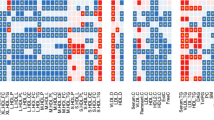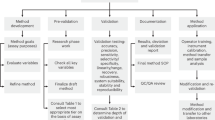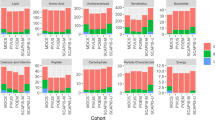Abstract
There is a clear case for drug treatments to be selected according to the characteristics of an individual patient, in order to improve efficacy and reduce the number and severity of adverse drug reactions1,2. However, such personalization of drug treatments requires the ability to predict how different individuals will respond to a particular drug/dose combination. After initial optimism, there is increasing recognition of the limitations of the pharmacogenomic approach, which does not take account of important environmental influences on drug absorption, distribution, metabolism and excretion3,4,5. For instance, a major factor underlying inter-individual variation in drug effects is variation in metabolic phenotype, which is influenced not only by genotype but also by environmental factors such as nutritional status, the gut microbiota, age, disease and the co- or pre-administration of other drugs6,7. Thus, although genetic variation is clearly important, it seems unlikely that personalized drug therapy will be enabled for a wide range of major diseases using genomic knowledge alone. Here we describe an alternative and conceptually new ‘pharmaco-metabonomic’ approach to personalizing drug treatment, which uses a combination of pre-dose metabolite profiling and chemometrics to model and predict the responses of individual subjects. We provide proof-of-principle for this new approach, which is sensitive to both genetic and environmental influences, with a study of paracetamol (acetaminophen) administered to rats. We show pre-dose prediction of an aspect of the urinary drug metabolite profile and an association between pre-dose urinary composition and the extent of liver damage sustained after paracetamol administration.
This is a preview of subscription content, access via your institution
Access options
Subscribe to this journal
Receive 51 print issues and online access
$199.00 per year
only $3.90 per issue
Buy this article
- Purchase on Springer Link
- Instant access to full article PDF
Prices may be subject to local taxes which are calculated during checkout




Similar content being viewed by others
References
Spear, B. B., Heath-Chiozzi, M. & Huff, J. Clinical application of pharmacogenetics. Trends Mol. Med. 7, 201–204 (2001)
Pagliarulo, V., Datar, R. H. & Cole, R. J. Role of genetic and expression profiling in pharmacogenomics: the changing face of patient management. Curr. Issues Mol. Biol. 4, 101–110 (2002)
Ingelman-Sundberg, M. Genetic variability in susceptibility and response to toxicants. Toxicol. Lett. 120, 259–268 (2001)
Nebert, D. W., Jorge-Nebert, L. & Vesell, E. S. Pharmacogenomics and “individualized drug therapy”: high expectations and disappointing achievements. Am. J. Pharmacogenomics 3, 361–370 (2003)
van Aken, J., Schmedders, M., Feuerstein, G. & Kollek, R. Prospects and limits of pharmacogenetics: the thiopurine methyl transferase (TPMT) experience. Am. J. Pharmacogenomics 3, 149–155 (2003)
Rang, H. P., Dale, M. M. & Ritter, J. M. Pharmacology (Churchill Livingstone, Edinburgh, 1995)
Tannock, G. W. Normal Microflora: An Introduction to Microbes Inhabiting the Human Body (Chapman and Hall, London, 1995)
Nicholson, J. K., Lindon, J. C. & Holmes, E. ‘Metabonomics’: understanding the metabolic responses of living systems to pathophysiological stimuli via multivariate statistical analysis of biological NMR data. Xenobiotica 29, 1181–1189 (1999)
Lindon, J. C., Nicholson, J. K., Holmes, E. & Everett, J. R. Metabonomics: metabolic processes studied by NMR spectroscopy of biofluids combined with pattern recognition. Concepts Magn. Reson. 12, 289–320 (2000)
Nicholson, J. K., Connelly, J., Lindon, J. C. & Holmes, E. Metabonomics: a platform for studying drug toxicity and gene function. Nature Rev. Drug Discov. 1, 153–161 (2002)
Nicholson, J. K. & Wilson, I. D. Understanding ‘global’ systems biology: metabonomics and the continuum of metabolism. Nature Rev. Drug Discov. 2, 668–676 (2003)
Lindon, J. C. et al. The Consortium for Metabonomic Toxicology (COMET): aims, activities and achievements. Pharmacogenomics 6, 691–699 (2005)
Shockcor, J. P. & Holmes, E. Metabonomic applications in toxicity screening and disease diagnosis. Curr. Top. Med. Chem. 2, 35–51 (2002)
Rawson, E. S., Clarkson, P. M., Price, T. B. & Miles, M. P. Differential response of muscle phosphocreatine to creatine supplementation in young and old subjects. Acta Physiol. Scand. 174, 57–65 (2002)
Zuppi, C. et al. 1H NMR spectra of normal urines: reference ranges of the major metabolites. Clin. Chim. Acta 265, 85–97 (1997)
Zoratti, R. A review on ethnic differences in plasma triglycerides and high-density-lipoprotein cholesterol: is the lipid pattern the key factor for the low coronary heart disease rate in people of African origin? Eur. J. Epidemiol. 14, 9–21 (1998)
Lenz, E. M. et al. Metabonomics, dietary influences and cultural differences: a 1H NMR-based study of urine samples obtained from healthy British and Swedish subjects. J. Pharm. Biomed. Anal. 36, 841–849 (2004)
Waterfield, C. J., Turton, J. A., Scales, M. D. C. & Timbrell, J. A. The correlation between urinary and liver taurine levels and between pre-dose urinary taurine and liver damage. Toxicology 77, 1–5 (1993)
Waters, E. et al. Role of taurine in preventing acetaminophen-induced hepatic injury in the rat. Am. J. Physiol. Gastrointest. Liver Physiol. 280, G1274–G1279 (2001)
Timbrell, J. A., Seabra, V. & Waterfield, C. J. The in vivo and in vitro protective properties of taurine. Gen. Pharmacol. 26, 453–462 (1995)
Coomes, M. W. in Textbook of Biochemistry with Clinical Correlations (ed. Devlin, T. M.) 473–474 (Wiley-Liss, New York, 1997)
Liu, L. & Klaassen, C. D. Different mechanisms of saturation of acetaminophen sulfate conjugation in mice and rats. Toxicol. Appl. Pharmacol 139, 128–134 (1996)
Smith, J. L., Wishnok, J. S. & Deen, W. M. Metabolism and excretion of methylamines in rats. Toxicol. Appl. Pharmacol. 125, 296–308 (1994)
Nicholls, A. W., Mortishire-Smith, R. J. & Nicholson, J. K. NMR spectroscopic-based metabonomic studies of urinary metabolite variation in acclimatizing germ-free rats. Chem. Res. Toxicol. 16, 1395–1404 (2003)
Grant, D. M., Tang, B. K. & Kalow, W. A simple test for acetylator phenotype using caffeine. Br. J. Clin. Pharmacol. 58, S788–S793 (2004)
Cloarec, O. et al. Evaluation of the O-PLS limitations caused by chemical shift variability and improved visualization of biomarker changes in 1H NMR spectroscopic metabonomic studies. Anal. Chem. 77, 517–526 (2005)
Cloarec, O. et al. Statistical total correlation spectroscopy: an exploratory approach for latent biomarker identification from metabolic 1H NMR data sets. Anal. Chem. 77, 1282–1289 (2005)
Claridge, T. D. W. (ed.) High-Resolution NMR Techniques in Organic Chemistry. Tetrahedron Organic Chemistry Series 19 (Elsevier, Amsterdam, 1999)
Bales, J. R., Sadler, P. J., Nicholson, J. K. & Timbrell, J. A. Urinary excretion of acetaminophen and its metabolites as studied by proton NMR spectroscopy. Clin. Chem. 30, 1631–1636 (1984)
Gregus, Z., Madhu, C. & Klaassen, C. D. Species variation in toxication and detoxication of acetaminophen in vivo: a comparative study of biliary and urinary excretion of acetaminophen metabolites. J. Pharmacol. Exp. Ther. 244, 91–99 (1988)
Acknowledgements
We thank the technical staff of Pfizer Global R&D in Amboise, France, for their assistance in performing the animal-related work, and thank R. L. Smith for discussions. T.A.C. thanks Pfizer for financial support. O.C. acknowledges the support of the Wellcome Trust (BAIR project).
Author information
Authors and Affiliations
Corresponding author
Ethics declarations
Competing interests
Authors J.R.E., R.J.W., D.B., C.C., G.H. and J.-L.L.N. are employees of Pfizer. Authors J.K.N. and J.C.L. have interests in Metabometrix in addition to holding academic posts at Imperial College London. Authors T.A.C. and O.C. are employees of Imperial College London with T.A.C. funded by Pfizer. H.A. holds an academic post at the University of Umeå, Sweden. In addition, T.A.C., J.R.E., J.C.L. and J.K.N. are named as inventors on patent applications relating to pharmaco-metabonomic technologies.
Supplementary information
Supplementary Table 1
This table describes the system for scoring the histology in individual liver lobes in the paracetamol study. (DOC 26 kb)
Supplementary Figure 1
This figure relates to the system for scoring the histopathological changes observed in individual liver lobes in the paracetamol study and contains four photographs showing microscopically-visible liver changes typical of histology scores 0, 1, 2 and 3, respectively. (DOC 738 kb)
Supplementary Table 2
This table summarizes the results of the standard clinical chemistry analysis of the blood plasma samples taken at ca. 24 h post-dosing in the paracetamol study. (DOC 39 kb)
Supplementary Methods
This file contains a detailed description of the methodology employed in the paracetamol study and outline descriptions of the studies on galactosamine and allyl alcohol. (DOC 60 kb)
Rights and permissions
About this article
Cite this article
Andrew Clayton, T., Lindon, J., Cloarec, O. et al. Pharmaco-metabonomic phenotyping and personalized drug treatment. Nature 440, 1073–1077 (2006). https://doi.org/10.1038/nature04648
Received:
Accepted:
Published:
Issue Date:
DOI: https://doi.org/10.1038/nature04648
This article is cited by
-
Unveiling the Therapeutic Potential: Metabolomics Insights into Medicinal Plants and Their Antidiabetic Effects
Current Food Science and Technology Reports (2024)
-
Metabolic profiling to evaluate the impact of amantadine and rimantadine on the secondary metabolism of a model organism
Scientific Reports (2023)
-
N-Acetylcysteine and Probenecid Adjuvant Therapy for Traumatic Brain Injury
Neurotherapeutics (2023)
-
Metabolomic profiling relates tianeptine effectiveness with hippocampal GABA, myo-inositol, cholesterol, and fatty acid metabolism restoration in socially isolated rats
Psychopharmacology (2022)
-
Metabolomic Evaluation of N-Acetyl-p-Benzoquinone Imine Protein Adduct Formation with Therapeutic Acetaminophen Administration: Sex-based Physiologic Differences
Journal of Medical Toxicology (2022)
Comments
By submitting a comment you agree to abide by our Terms and Community Guidelines. If you find something abusive or that does not comply with our terms or guidelines please flag it as inappropriate.



